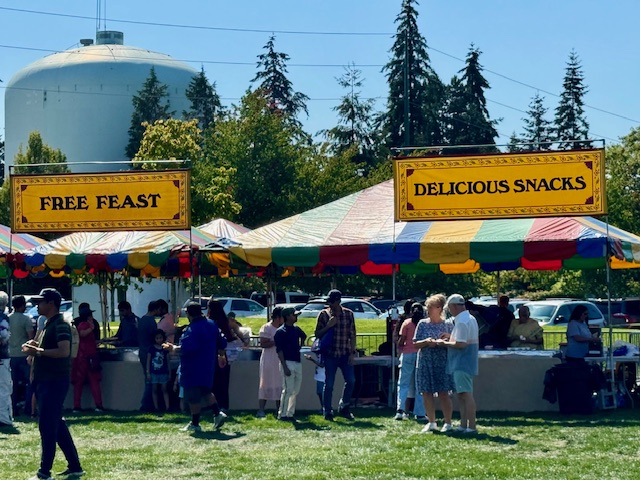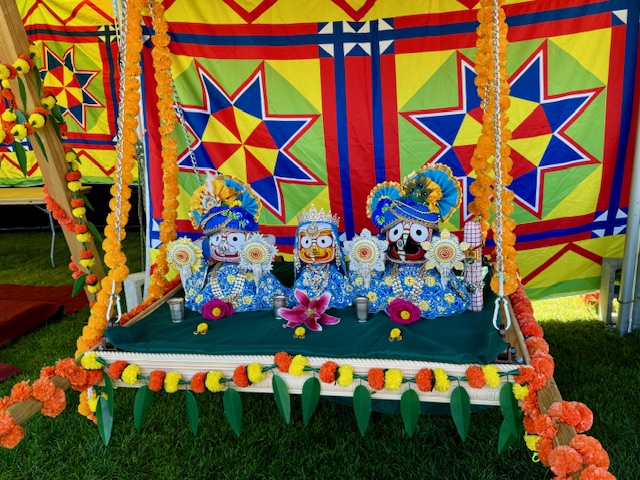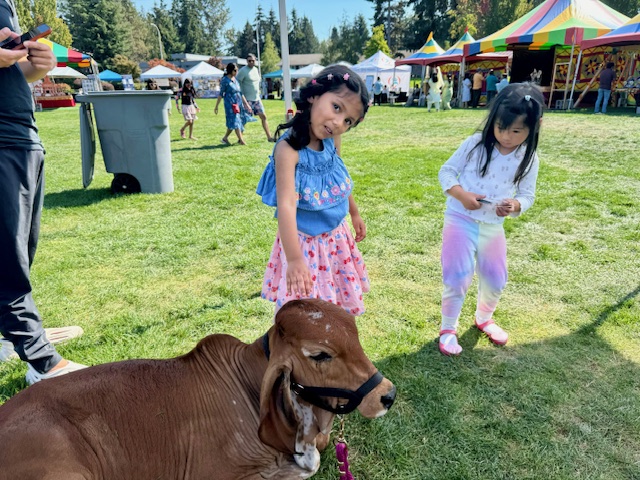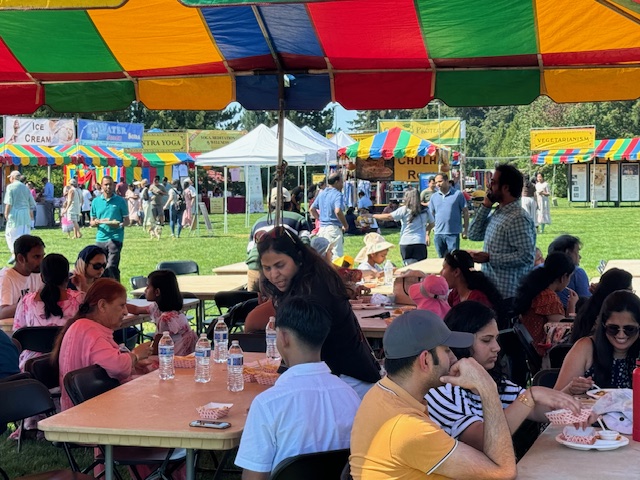Antya 9.13-26 Provoking powerful people over their peculiarities is perilous – Chaitanya Charitamrit
Antya 9.1-12 How beholding Lord Chaitanya filled people with ecstasy – Chaitanya Charitamrita study
→ The Spiritual Scientist
Inner transformation – from wild forest to agricultural field to Vrindavan | Bhagavatam 10.63.26
→ The Spiritual Scientist
Things that are worth doing, are worth doing well — and worth doing badly too Gita 06.26
→ The Spiritual Scientist
The more we watch the mind’s movie, the more the mind makes our life a horror movie Gita 06.06
→ The Spiritual Scientist
Even if we can’t flatten the pandemic curve, we can flatten the panic curve Gita 18.35
→ The Spiritual Scientist
Even though we have more enemies than we realize, we also have more friends than we realize BG 10.10
→ The Spiritual Scientist
The more we consider others’ need, the more we can free ourselves from our greed Gita 05.21
→ The Spiritual Scientist
Even if our consciousness can’t be elevated, it can still be expanded Gita 02.13
→ The Spiritual Scientist
As long as we lack purity, we live in poverty, no matter how much money we have Gita 14.12
→ The Spiritual Scientist
Appreciating our spiritual identity can anchor us amid the turbulence of contemporary society 02.16
→ The Spiritual Scientist
Respond to moral failure not by mental punishment but by spiritual reinstatement Gita 09.30
→ The Spiritual Scientist
By overemphasizing identity, identity politics ends up obscuring identity Gita 02.13
→ The Spiritual Scientist
Without spiritual direction, religious regulation seems to be like pointless restriction or even pai
→ The Spiritual Scientist
Bhagavad Gita Overview Chapter 8
→ The Spiritual Scientist
Inauguration Of Sridham Mayapur Board of Education
→ Mayapur.com
ISKCON Environmental Initiative Invites Devotees to Participate in World Cleanup Day
→ ISKCON News
World Cleanup Day, a global event aimed at combating litter and waste pollution, is a cause that resonates deeply with ISKCON’s values of environmental stewardship. The ISKCON Environmental Initiative (IEI) is calling on our temples, congregation members, temple devotees, youth groups, and nama hatta groups worldwide to participate according to their capacity, reinforcing our shared […]
The post ISKCON Environmental Initiative Invites Devotees to Participate in World Cleanup Day appeared first on ISKCON News.
2024 Pan-African Vyasa-puja Book Now Available for Download
→ ISKCON News
The Bhaktivedanta Book Trust Africa (BBTA) has once again honored the legacy of His Divine Grace A.C. Bhaktivedanta Swami Prabhupada with the release of the 2024 Pan-African Vyasa-puja book. This annual offering, now available for free download on the Bhaktivedanta Book Trust-Africa (BBTA) website, provides a platform for devotees, friends, and well-wishers across the African […]
The post 2024 Pan-African Vyasa-puja Book Now Available for Download appeared first on ISKCON News.
Seattle Rathayatra Festival
→ Ramai Swami


Each year I try to come for the Seattle Rathayatra, which goes over two days during the Labor Day long weekend. The first day started at a local park where devotees and guests came with their families.
As you can see in the pictures, there were stalls with free prasadam, snacks, books, kirtan and drama stage, and many others. A favorite attraction were the areas with calves and goats from one of our nearby farms. Their Lordships, Jagannatha, Baladeva and Subhadra sat on a beautiful swing.


A Dream Fulfilled: The Majestic Unveiling of ISKCON Raipur’s New Temple
→ ISKCON News
The auspicious inauguration of ISKCON Raipur was held from August 17-19, 2024. The special grand installation ceremony of the Deities, Sri Sri Radha Rasabihari, took place on August 19th on the occasion of Balaram Jayanti, Lord Balarama’s Appearance Day. Raipur, the capital city of Chhattisgarh, is a vibrant and rapidly growing metropolis in central India. […]
The post A Dream Fulfilled: The Majestic Unveiling of ISKCON Raipur’s New Temple appeared first on ISKCON News.
2024 BeatlesFest Speech
→ Dandavats
Read More...
We can’t foresee every consequence of our actions, but we can foresee their probable consequences
→ The Spiritual Scientist
Transform depressing loneliness into nourishing solitude by seeking spiritual purpose Gita 13.11
→ The Spiritual Scientist
हिंदी- How Krishna prepared the world stage for Prabhupada to dance | Prabhupada Appearance Day 2024
→ The Spiritual Scientist
Hindi Krishna Charitra 5 | Krishna in Kurukshetra | Govinda Damodara Stotra 1 | Nashik
→ The Spiritual Scientist
Faith is seen through both firmness in intention and flexibility in execution Gita 09.14
→ The Spiritual Scientist
Might Nature Be Teaching Us To Stop Believing That We Humans Alone Matter On The Earth Gita 14.04
→ The Spiritual Scientist
Hungary Yatra Celebrates Its 30th Annual Padayatra with 120 km Journey
→ ISKCON News
Some of the participants of the ISKCON Hungary Padayatra. The ISKCON Hungary Yatra completed its 30th annual padayatra recently, a 14-day event from July 8th to 21st. Devotees walked 120 kilometers, beginning their journey in the northern city of Eger. The padayatra’s organizer, Triyuga Das, reflected on the significance of this milestone and the importance […]
The post Hungary Yatra Celebrates Its 30th Annual Padayatra with 120 km Journey appeared first on ISKCON News.
Hindi Krishna Charitra 4 | Krishna in Mathura & Dwarka | Govinda Damodara Stotra 32 & 27 | Nashik
→ The Spiritual Scientist
Hindi Krishna Charitra 3 | Krishna in Vrindavan 3 | Madhurya-rasa lila – HG Chaitanya Charan Das
→ The Spiritual Scientist
Questions And Answers 25 June 2024
→ The Spiritual Scientist
Finding Happiness Through Desire Management – 2 Youth Boston
→ The Spiritual Scientist
Finding happiness through desire management – 1| Youth | Boston
→ The Spiritual Scientist
4 Levels Of Understanding Krishna’s Appearance Janmashtami 2024 Class
→ The Spiritual Scientist
Democratic Republic of Congo Celebrates its First-Ever Rathayatra
→ ISKCON News
Bhakti Carudesna Swami, Mahavishnu Swami and Yugala Kishora Das greeting local officials. From July 11th to 13th, 2024, the streets of Kinshasa burst into life with the vibrant sights and sounds of the first-ever Rathayatra festival hosted by the International Society for Krishna Consciousness (ISKCON) in the Democratic Republic of Congo (DRC). This groundbreaking event […]
The post Democratic Republic of Congo Celebrates its First-Ever Rathayatra appeared first on ISKCON News.
Inauguration Of Sridham Mayapur Board of Education
→ ISKCON News
Jayapataka Swami and one of the Co-Directors of Mayapur, Subhekshana Dasa speaking about the inauguration at the Pancatattva Hall in Mayapur. On August 20, 2024, the Co-Directors of ISKCON Mayapur officially inaugurated the Sridham Mayapur Board of Education, marking a significant step toward enhancing and transforming the educational scenario of Mayapur. The Board’s focus will […]
The post Inauguration Of Sridham Mayapur Board of Education appeared first on ISKCON News.
The Lady General Of Sri Madhava’s Abode!
→ Mayapur.com
Hare Krsna TV Celebrates 8 Years of Spiritual Broadcasting
→ ISKCON News
Radhanath Swami meets and blesses the Hare Krsna TV Team. August 26th- Hare Krsna TV, a leading spiritual television channel dedicated to promoting the teachings and values of Lord Krishna, is celebrating its 8th anniversary today. Launched on Janmashtami 2016, the channel has grown significantly, reaching millions of viewers across India and around the world. […]
The post Hare Krsna TV Celebrates 8 Years of Spiritual Broadcasting appeared first on ISKCON News.
ISKCON Miraroad celebrates Janmashtami in Schools
→ Dandavats
Read More...
Vyasa-puja Offering to Srila Prabhupada
Giriraj Swami
 My dear Srila Prabhupada,
My dear Srila Prabhupada,
Please accept my prostrated obeisances at your lotus feet. All glories to Your Divine Grace and to your sublime, causeless mercy.
In recent years, recognizing the crucial importance of devotee care, devotees throughout the movement have opened hospitals, hospices, and other facilities; organized mentoring and counseling programs; and made accommodations for devotees of all ages and abilities. Srila Prabhupada, you were the embodiment of devotee care, always looking after us, your disciples, to ensure our physical, emotional, and spiritual health.
After the first Delhi pandal, at Dalmia Bhavan, when Yamuna Devi fell ill and was recuperating in isolation in a closet in the devotee quarters, she remembered “Srila Prabhupada noticed I was missing, and I was later told that he had inquired many times where I was.
“One day I became aware of the door being opened, and I turned to see Srila Prabhupada’s lotus feet walking into that closet room. . . . He placed his hand on my head and inquired, ‘Yamuna? How are you doing?’ Firstly I said, ‘I am always thinking of you, Srila Prabhupada.’ Then I explained my symptoms, and he said, ‘I think this is jaundice [hepatitis] . . . Now I will take charge of your recovery. You will never get well in these conditions on the floor.’
“Srila Prabhupada had a hospital bed brought in for me and moved me into a room right next to his, with floor-to-ceiling windows, neem trees outside, and a fan. And I remember being propped up in this bed, and he came in every day to check on my progress.
“He also called in an Ayurvedic doctor and gave me a diet for jaundice. He said I had to take something called petha, a wax gourd or a white kind of pumpkin taken raw. It’s covered in a thick layer of caramelized sugar, so to me it looked like a ghastly thing to eat. Srila Prabhupada said, ‘This is your medicine. You have to eat it every day; and you also have to drink sugarcane juice.’ So, I remember the first time I took a bite of petha; it tasted like the most bitter, horrible thing because of the jaundice. Srila Prabhupada would personally stand and watch me eat the petha, and he would actually smile and chuckle.”
You were especially protective of your women disciples, and in India you had them ride to programs with you in your car. During the 1970 Indore pandal festival, when a man reached up and pulled on one of the women’s saris, you immediately stopped your dancing, rushed to the edge of the stage, and swung your kartals toward the man’s face, shouting “Stop this!” Although little-noticed by the crowd, your burst of lionlike ferocity impressed and inspired us, and we knew that we were all under your protection.More than once, you stopped your own Vyasa-puja to inquire about devotees’ health and welfare. “In one case,” Malati dasi recalls, “you asked after the well-being of a devotee who hadn’t been there for some time. When the devotee explained that he had been in poor health, you asked, ‘Are you getting what you need? Are you being taken care of? If you need anything, ask me.’ ”
I too was a beneficiary of your personal care. When I joined, my parents had some doubts. They did not object to my remaining in the movement, but they did not want my health to deteriorate, and they wanted me to be stationed near home. When they came to visit me in Calcutta, you encouraged me to spend time with them, to ease their worries and let them know that I was being well taken care of—which I was.
You received them warmly and graciously. When they expressed their concerns to you directly, you told them, “Do not worry; I will take personal care of him.” And when they remained apprehensive, you said, “Let him stay with me in India for some months more, and I will take personal care of him. Then, when I return to America in April, he can come with me.”
“Just see how intelligent Srila Prabhupada is,” I told them. “In the winter, when the Western countries are cold and dark, he stays in India. And in the summer, when the West is warm and sunny, he goes there.” And indeed, they were somewhat relieved. “Yes, he is very intelligent,” my father agreed.My mother, however, still thinking of my poor health and long absence from home, began to cry. I was quite thin, and she was concerned. People in the West had the idea that if you didn’t eat meat, you wouldn’t get enough protein.
To cheer her up, you gave her a sandesa. At first, she wouldn’t accept it, but your kind and gentle persistence prevailed. You told her, “These sweets—sandesa and rasagulla—are made of cheese and are very high in protein.” Then you said, “Giriraj, you must take at least two dozen sandesa and rasagulla every day. Then you will become strong and healthy.”
You assured my parents, “I will personally see that he is supplied with sufficient sandesa. Do not worry.” Everyone was thoroughly pleased and satisfied by your loving dealings. As my father was leaving the room, he remarked, “Well, I can say two things about your master. He is a brilliant organizer, and he really knows how to deal with people.” And in my father’s system of values, those were the highest compliments.
After Calcutta, in Madras, I was living at different people’s homes and, eating lots of good idlis and dosas and sambar, I put on weight. Eventually I arranged a program for you, and when you came, you saw that I had gained weight and said, “You should take a picture of yourself and send it to your mother.” You hadn’t forgotten about my health—or about my mother.
You also cared for us by protecting us from becoming discouraged in our service. Establishing the Juhu temple required a great deal of funding, for instance, and there were many legal and practical complications. During one period I would go into the city and stay all day every day to meet with people. It was quite a distance, and I would travel there and back in a crowded train and to and from the train station in a crowded bus. Usually I would return just in time to take some prasada and attend the kirtan and class.
When approaching prospective contributors, if someone didn’t want to become a life member, I would ask him to place an advertisement in one of our publications. If he didn’t want to place an ad, I would ask him to buy a set of books. If he didn’t buy a set of books, I would ask him to give a donation, or at least buy one book, or at least give something to help. And in the evening, I would report to you about my preaching.
At the end of one day I was feeling particularly discouraged. I’d gone to many people, but most of them had refused to meet me and the one or two I had met were not interested in helping. Not one person had contributed in any way. When I told this to you, you said, “Don’t be discouraged. If you sincerely try your best to please Krishna, Krishna will be satisfied—even if others are not.”I considered your words. The people I had met may not have been satisfied, and so they had not contributed. And even the devotees may not have been satisfied, since I had not achieved any desired results. But if Krishna was satisfied, what else mattered? I understood that if I sincerely tried to serve Krishna without any selfish motive, Krishna would be pleased, regardless of the results. You always encouraged us, no matter what was happening.
After another long day, I staggered up to your room, exhausted, to give my report. You looked at me and asked, “How are you feeling?” Only then did I notice how weak and sick I was. “Well, frankly speaking, Srila Prabhupada,” I replied, “I feel a little tired.” You already knew, and you immediately ordered some grapes for me, which you said were good for strength and energy. You insisted that I eat them in your presence, and after a minute or two you asked if I was feeling stronger. Yes, I replied, I was. “To work very hard for Krishna for two days,” you concluded, “and then to recuperate for three days¾that is not a very good proposal.”
In your care for us as your disciples, you took it as your duty to make sure we had proper accommodations. One of your most prominent householder devotees in Bombay, Mr. P. L. Sethi, was a building contractor, and when he built additional floors on the top of the six existing tenement buildings on the Juhu property to house the devotees, you told him, “Just as you are building these rooms for my disciples here, Krishna will be preparing your room for you in Vaikuntha.” “I’m a sinful man,” Mr. Sethi replied—though he wasn’t—“how can I go to Vaikuntha?” And you said, “You don’t worry—I’ll manage that.”
Of course, you also took care of us spiritually, and you taught and led us by example. At the Ardha-kumbha-mela in 1971 we were living in tents, and you were also living in one. We were expected to get up at four in the morning to bathe and attend mangala-arati, but it was so cold that we preferred to stay in our sleeping bags rather than come out and face that biting cold air. And consequently, we were missing mangala-arati.
You knew how important mangala-arati and the rest of the morning program was for us, and when you noticed that some of us were coming late and some were not coming at all, you became concerned. So, one morning, even though your health was somewhat frail in health, you got up at four o’clock and came out in your gamcha, sat down under the hand pump, and took an ice-cold bath—just to encourage us to get up, bathe, and go to mangala-arati. This action had a profound effect on all of us, and we felt so ashamed that from that morning on, we just couldn’t sleep late anymore.
You also cared for the children. In Los Angeles you would distribute cookies to them after the Deity greeting. In Juhu, on your instruction, we held classes for the tenants’ children, and many of them would attend mangala-arati or the evening program. You even had us schedule mangala-arati a little later so that it would be easier for our neighbors to attend. The whole area surrounding Hare Krishna Land was “a pious quarter,” you said, and you wanted us to do whatever we could to maintain a school for the local children, who, as young as they were, learned our regulative principles and how to offer food to Krishna.
Before you left Bombay, you directed that we should establish our own Krishna conscious school system. You wrote me from Sydney, “As soon as possible we should open our own school and teach children Krishna consciousness through English medium—that is one of our programs. Our school will not be government recognized, because we cannot follow the government syllabus. We want to teach only Krishna consciousness. . . . I know many parents are eager to educate their wards through English medium. If we can introduce this system, our girl disciples may be engaged for teaching them: a little English grammar, reading and writing, geography, arithmetic, history, Sanskrit, but all of them should be Krishna conscious—that is the Bhagavata program.”
You also extended your care to the Deities, especially in Juhu to protect Sri Sri Radha-Rasabihari. Acquiring the land and building the temple was an enormous undertaking and required that you do battle with some of the worst villains in Bombay society, but you promised Sri Rasabihari, “My dear Sir, You just come and sit here and I will build You a temple.”
And you took great care to see that They were worshipped properly. When the temple was still under construction, They were in a pandal, on a platform of wooden planks. It wasn’t very secure, but a devotee stood guard all night to protect Them and Their paraphernalia. One night, however, the devotee on duty fell asleep, and some thieves slipped under the canvas, stepped over the sleeping brahmachari, and stole the Deities’ crowns and flute.
When you heard about the incident, you wrote me, “I have got some reports that the Deities in Bombay are being much neglected. This is most abominable affair. Radha and Krishna should not ever be neglected or left unprotected, so I am wondering what you have done to rectify this situation. I have heard that Madhudvisa intervened to get the Deities a better place, so he has done nicely.”
I was shaken that you had criticized me so severely, but I replied, “You are so merciful to take the time to chastise this useless soul. My sluggishness and thoughtlessness are very shameful, and worst of all, before receiving your letter, I was so unconscious of them. But your absolute mercy is such that your chastisement is as good as your blessings. So I pray that my determination and enthusiasm shall not be shaken in trying to follow your instructions.
“As far as the Deities are concerned . . . highly decorative cloth has been put on the sides of the Deities’ house, and for Their protection we have had all-day watch by devotees, and three men sleeping around the Deities at night. Soon the new structure should be up, and until then we shall have all-night awake watch for the Deities, beginning tonight. The Deity room in the Khandelwal structure will be pukka, brick and sheets, with a locking door.”
You replied later that month: “I am glad to see that all of the programs are going on nicely, especially that the Deities are being cared for again properly. Now you give our ladies full facilities and help them by giving them money and other things wherever required by them so that our Deity program will not be lacking.”
I wrote back, “The Deity program is expanding, and nearly every day a new item appears on the altar. The Deities’ lotus has returned, dipped in silver. And the girls have arranged to purchase marble for the altar. Madri Dasi and others have already got three nice donations for Their Lordships. When the Deities are moved into Their new home, we will feel very relieved and encouraged.”
You wrote that I should buy a safe and keep the Deities’ jewelry secured—it wasn’t real jewelry, but people might think it was. And you gave many detailed instructions about how to protect the Deities and Their paraphernalia.
Srila Prabhupada, as your Krishna consciousness movement spread throughout the world, caring for the devotees remained one of your most prominent concerns. And, inspired by your instruction and example, we are trying to continue that effort, promoting devotee care and prioritizing devotees’ physical, mental, and emotional health as well as their spiritual well-being.
Hare Krishna.
Your eternal, grateful servant,
Giriraj Swami